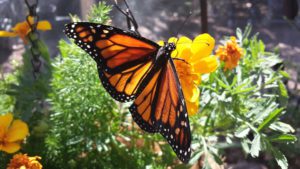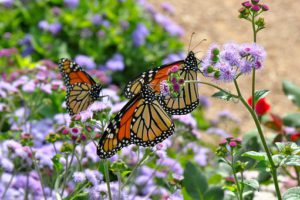A Complete Guide on the Monarch Butterfly

The monarch butterfly can bring that much-needed flavor to your gardens and landscapes with their beautiful colors. These butterflies are popular and can be seen in gardens gracefully flying from plant to plant collecting pollen, this is one of the many wonders of nature which can have gardens teaming not only with their beauty but with excitement as we watch them in their natural habitat.
Get kids on board as they watch these fascinating wonders of nature help in bringing balance to the ecosystem with their presence and activity. This is a great way to teach kids not only about plant life but wildlife and the contributions they bring, my childhood days were full of excitement as both my friends and I went butterfly watching along with catching a few which help to make school break on those long summer days so great. Below we will be discussing this popular butterfly along with looking at some fun facts. If you are a butterfly lover and would like to know more about the monarch butterfly then continue reading as we take this exciting journey together.
History of the monarch butterfly
The monarch butterfly or (Danaus plexippus) is one of the most recognized butterflies which is native to North and South America. They can be easily spotted by their wing pattern that is black orange and white.
During late summer to autumn, these butterflies by the millions set off on their migration Southward from the Northern and Central United States all the way South of Canada to Florida and Mexico.
Monarch butterflies travel thousands of miles during the fall migration, West of the rocky mountains the Western North American monarchs overwinter in Mexcian sites also migrate in sites South of California.
The life cycle of the monarch butterfly
The monarch butterfly goes through four stages, these stages are egg, larva, pupa, and then adult. The female lays her eggs on the underside of milkweeds, the larva begins to mature and chews its way out the egg. Once the egg hatches the worm-like larva emerges, after the eggshell has been consumed by the larva it starts to feed on nearby leaves.
The larva is a huge eater and will continue to eat and eat until it outgrows its skin. Molting takes place during this time, the old skin splits as newer skin appears. The larva will then free itself from this skin consuming it also, feeding will continue by feasting on the leaves of milkweeds.
The larva will continue to go through four more stages of molting, with the last molting the larva will look for a suitable place to wave a mat made of silk with a button in the center, the larva then grips the mat tightly with its legs and hang upside down. A J form or shape is made by the body of the larva.
The skin then splits behind the larva head, the larva will then wiggle until the skin is removed while it hangs in an upside position. A hook-like structure is embedded into the larva’s rear end into the button causing the remainder of the skin to remove easily.
Once the skin is removed the larva moves onto the pupa stage, at this stage the monarch has no legs, antenna, or eyes. During this process which can take up to a week, there is no movement while changes are being made inside which is a great transformation. What happens at the end of this week’s period is a beautiful butterfly emerges.
Though the butterfly emerges it cannot take to the open sky but must wait for two hours pumping body fluid into its veins small shriveled wings. This pumping of fluids will cause the wings to get bigger, there is still a waiting process while air replaces some of the fluids. Once the wings have hardened the monarch butterfly can now take to flight.
Attracting the monarch butterfly to my garden
You have done some research on the monarch butterfly and would like to make your garden inviting to them here is what to do.
1. Locate an area in your garden that receives about six hours of sunlight. This area will not only help your plants to thrive but butterflies, for the most part, love to feed in sunny areas.
2. Garden plants are the main feature of attracting these butterflies. Here are a few that will not only attract the monarch but will have your garden bursting with beautiful colors.

- Milkweed
- Cosmos sulphureus
- The Mexcian sunflower
- Zinnias Flowers
- Lantana
- Dwarf butterfly bushes
- May night salvia
- Brazilian Verbena
- Lilac
- Ava Flower
- Miss molly bush
The key to attracting butterflies is not only the installation of these listed plants but knowing how to care for them (plants) so they can continue to grow healthy. Get to know the care of these plants to attract and keep the monarch butterfly around. There are many types of milkweeds so ensure that the ones that are chosen are native to your Zone.
3. When installing garden plants use a variety of bright colors because this is what attracts butterflies. The flowering tubes of garden plants should be short.
4. Creating a puddle station will have your colorful friends excited, all a puddle station consists of is filling a shallow pan or two with water and adding a bit of sand. The dish or pan should be placed in a sunny area. A dump muddy area will also provide minerals and water.
5. Placing a few flat rocks in a sunny location will encourage them to rest kick back and relax.
15 Monarch butterfly fun facts
1. A female monarch butterfly can lay anywhere from 300-500 eggs.
2. A monarch butterfly uses its legs and antennae to smell and taste. Chemoreceptors are sensory cells that are found on the monarch’s butterfly legs. The reason for these sensory cells is to help them to find milkweed to lay their eggs on.
3. The caterpillar stage of the butterfly has been know to eat its skin that is shed.
4. The monarch butterfly flaps its wings very slowly which is 5-10 times per second compared to other butterflies that flap their wings 20 times per second.
5. The female monarch butterfly lays her eggs on the underside of milkweeds.
6. Monarch butterflies can travel from 50-100 miles in a single day.
7. They use thermals and air currents to travel great distances.
8. It’s believed that these butterflies can become toxic to birds by feeding on milkweed plants.
9. The caterpillar stage of the monarch butterflies are huge eaters.
10. To tell a female monarch butterfly from the male is simple just take note of the wing pattern. On the hind wings of the male, you will find two black spots while on the female the black border is slightly thicker.
11. Monarch butterflies are highly prized.
12. The caterpillar is a voracious eater that will consume an entire milkweed leaf.
13. Monarch’s origin began in North America.
14. The monarch butterfly is the state insect of 5 USA STATES.
15. The surface of their wings is covered with thousands of colorful scales.
Additional information
1. Don’t use pesticides in your garden as they can harm the monarch butterfly.
2. The good bugs are depending on you to keep your garden pesticide-free so they can feed on the bad bugs.
3. Increase good bugs in your garden by installing plants that attract them. You can also purchase beneficial insects from your garden center and release them into your garden.
4. Install native plants that will thrive in your zone.
5. Don’t kill caterpillars thinking they are garden pests which might be the larva of the monarch butterfly.
6. The use of a 3-inch layer of mulch around garden plants will help to keep down weeds.
7. Install plants in masses or bunches.
8. Filling a bowl with fruits that are marsh and overripe will attract them. Soaking dish towels in fruit juices and hanging them from trees and shrubs will have your monarch buzzing with excitement.
9. When watering plants water at the ground level to avoid knocking the larva from garden plants.
10. Including ferns and grasses will also provide shelter.
11. Rocks and evergreen plants will help in absorbing the heat.
12. The use of organic and synthetic fertilizers ( manmade) can be used, however, when using fertilizers read and follow the manufacture’s direction for best results.
A final word about the monarch butterfly
Wildlife gardening is pretty amazing, these garden types can really bring that much-needed flavor with excitement and activity as your garden comes to life with the monarch butterfly as you watch them in their natural habitat.
Having a wildlife garden is a great way to go butterfly watching from your home garden which I think is so amazing. Installing native plants into your garden that will draw the monarch butterfly is a great way in helping to provide a home and food source while giving nature a helping hand bringing balance to the ecosystem so go for it you will be so happy that you did as your garden is filled with activity for both you and your kids to enjoy.
About the author
Norman loves being in the garden, both at home and for his job....
he is 'Natures Little helper' being outdoors, growing his vegetables and flowers from an early age.
Now having spent over 22 years in the profession he want to give some of his knowledge to others...
his vast array of hints and tips you will find scattered over this site will help you no end growing plants in your garden.
